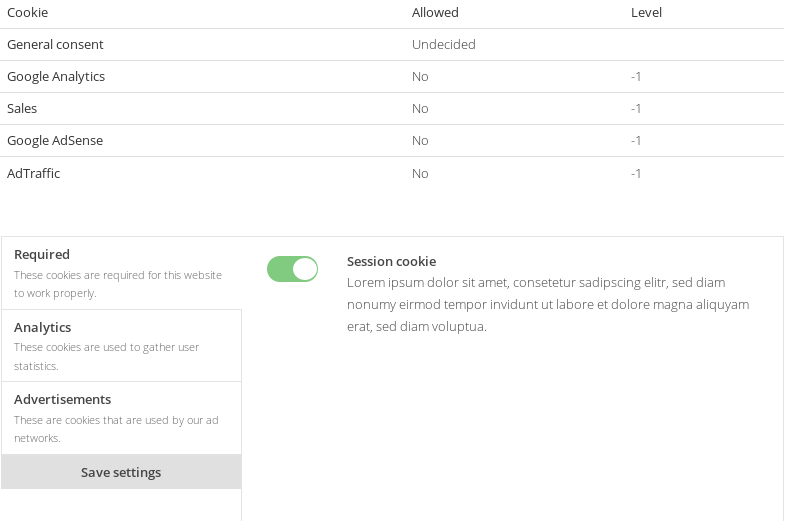Download the PHP package offline/oc-gdpr-plugin without Composer
On this page you can find all versions of the php package offline/oc-gdpr-plugin. It is possible to download/install these versions without Composer. Possible dependencies are resolved automatically.
Download offline/oc-gdpr-plugin
More information about offline/oc-gdpr-plugin
Files in offline/oc-gdpr-plugin
Package oc-gdpr-plugin
Short Description October CMS plugin to make websites GDPR and ePrivacy compliant
License MIT
Informations about the package oc-gdpr-plugin
oc-gdpr-plugin
October CMS plugin to make websites GDPR compliant.
This plugin is available on the October Marketplace: https://octobercms.com/plugin/offline-gdpr
Features
- Cookie Consent Manager
- Data retention
Cookie Consent Manager
This plugin provides two simple components to make your October installation GDPR compliant.

Quick start
- Define your cookie groups and cookies via the backend settings page.
You can also import a example preset by running
php artisan gdpr:import - Place the
cookieManagercomponent on acookies.htmpage -
Place the
cookieBannercomponent on all of your layouts. Use the configuration listed below. -
Create a new
gdpr.htmpartial. Include the partial in your layouts as shown below. Note the#gdpr-reloadwrapper. - Inside your
gdpr.htmpartial you can now conditionally include your dependencies by querying the cookie'scode.
Cookie manager
The cookieManager component gives a visitor more control over the cookies your site is using.
This component can simply be placed on a page and needs no further configuration.
Cookie presets
It is possible to define your cookie groups and cookies in a yaml file and import them using the gdpr:import console command.
This allows you to define cookies once and re-use them between installations.
You can find example definitions in the assets/presets directory of this plugin.
You can optionally use the --replace flag to remove all existing cookie data and replace it with your preset.
If no path is specified, the plugin will load all presets from the configured presets_path and ask you which preset to import.
You can change the path where presets are loaded from by changing the offline.gdpr::config.presets_path config entry.
To do this, create the file config/offline/gdpr/config.php and return your custom path:
cookieBanner

The cookieBanner component displays a cookie banner on the first page view. There the user has the possibility to
enable and disable cookies that your website uses (defined via October's backend settings).
These settings are stored and made available in your partials using the gdprCookieAllowed helper. With this helper
you can check for the user's consent and optionally include your resources.
Installation
- Define your cookie groups and cookies via the Backend settings
- Add the
cookieBannercomponent to all your layouts.
Log
You can enable a log via the backend settings so every cookie banner request gets logged. This is useful to get an idea of the number of users that do not accept a cookie request and therefore never end up in your analytics data.
The log only contains the user's session id and their decision.
Properties
If you don't want to include the default css use include_css = 0 when including your component.
cookieManager page
Set the property cookie_manager_page to the page that contains the cookieManager component.
A Advanced Settings link will be placed on the cookieBar that links to this page. This enables the user to
further define what cookies are allowed.
Twig Helpers
gdprCookieAllowed($code, $minLevel = 0)
Check if a certain cookie is allowed to be included. You can optionally pass a cookie level to check if the user has accepted a specific level of this cookie.
gdprAllowedCookieLevel($code)
Get the max allowed level for a certain cookie. A return value of -1 means the cookie is not allowed at all. A
value of 0 or higher means the cookie is allowed with the returned level value.
gdprIsUndecided()
Check if the user has made a decision about the cookies yet. This will return true on the second page view if the
user did not interact with the cookieBanner (silent opt-in).
Data retention
The data retention functionality enables you to delete old plugin data after a specified amount of days.
You can specify the data retention policy for each plugin via October's backend settings.
Important: To automatically delete old data make sure you have set up the Task Scheduler correctly.
Register your plugin
To register your plugin you have to listen for the offline.gdpr::cleanup.register event in your Plugin's boot method.
You have to specify the following data:
| key | information |
|---|---|
| id | A unique identifier of your plugin |
| label | A human readable label for your plugin |
| models | An array of all your data collecting models |
As models you have to specify an array with the following data:
| key | information |
|---|---|
| id | A unique string to identify this model. Use only _-a-z0-9. Only required if you specify a closure. (ex. offline-gdpr-spam-messages) |
| label | A human readable label for the backend switch form widget |
| comment | A human readable comment for the backend switch form widget |
| closure | A closure that is called when the cleanup job is run. Make sure to also define an id. |
| class | A model class that defines a gdprCleanup method |
You have to specify either a closure or a class value. If both are specified the closure value will be used.
Cleanup method
You can either specify a closure or a model class that defines a gdprCleanup method. Both have the same
signature:
This method is called whenever the cleanup job is run. $deadline contains a Carbon instance.
All data older than this date has to be deleted. $keepDays contains the number of days
that $deadline is in the past.
Make sure to use an each/delete loop if your model makes use of deleting/deleted model events.
Cleanup command
You can trigger the cleanup on demand via
php artisan gdpr:cleanup


